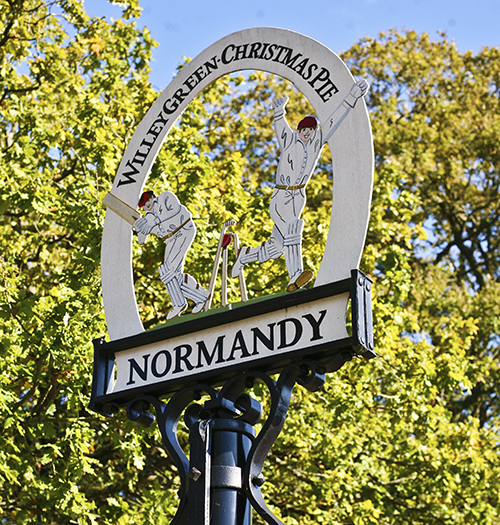1. In its leaflet, distributed to households in Normandy Parish to announce its first ‘Public Consultation event’ on Friday, 18 July, and on its website, Taylor Wimpey (TW) states that its ‘Emerging Vision’ for its site at Normandy and Flexford includes:
- A mix of new homes – including 50% affordable
- Dedicated homes reserved for the elderly
- A new community hub for use by local people within a dedicated local centre, including space for local shops
- New open space made available to the public with supporting facilities
- Potential for new education facilities and supporting open space.
- Plans for a new bus through-route, mobility hub, and e-bike facilities.
2. This article examines each of these claims in turn, aiming to give residents relevant background information that will help them to ask the right questions and make up their own minds about TW’s ‘vision’. It turns out that most of what is claimed is simply a reflection of any developer’s obligations under existing planning regulations.
Affordable homes
3. There has for long been a requirement for developments of any scale to include a proportion of so-called ‘affordable’ homes. There are two problems with this. First, the homes are not truly ‘affordable’, usually defined as being at a maximum of 80% of market rate, i.e. hardly affordable by young families looking to get on the housing ladder. Second, the big developers often succeed in having their affordability commitments reduced once the development has started, on grounds of ‘viability’ (i.e. if they make too many homes ‘affordable’ they won’t make enough profit).
4. The recently revised National Planning Policy Framework (NPPF), para 67, outlines new requirements for ‘affordable’ homes to be built on land released from the Green Belt (as per paras 156 and 157 of the NPPF). These “require at least 50% of the housing to be affordable, unless this would make the development of these sites unviable (when tested in accordance with national planning practice guidance on viability)”. TW’s 50% claim is therefore simply a statement of policy and regulatory requirements – and note the caveat.
Homes for the elderly
5. The NPPF (para 63) requires that the needs of older people be reflected in planning policies (and therefore decisions on planning applications), but leaves the detail to be set by local planning authorities. Guildford Borough Council (GBC) addresses this in Policy H1 ‘Homes for All’ of its Local Plan. There are, therefore, existing obligations on developers to take the needs of older people into account in planning new developments such as this one.
A new community hub
6. This might seem rather strange given the recent creation of the Normandy Shop and Café alongside the existing Village Hall and other facilities at Manor Fruit Farm, the former having emerged since TW’s previous attempt to develop this site in 2016. It is something of a circular argument to claim that a hub will be needed to serve all the new homes, when if you did not have the homes, you would not need the additional hub.
New open space
7. Again, this is a regulatory requirement, covered by Policy P5 of the Guildford Local Plan: ‘Thames Basin Heaths Special Protection Area’ (TBHSPA), which outlines the approach to Suitable Alternative Natural Greenspace (SANG) that must be provided if development occurs within a certain distance of the TBHSPA (in our case, this means the Ash Ranges). This is why, on TW’s outline plan of the site they intend to develop, there are two signs to the left saying, “To SANG”.
8. SANG is generally very unpopular because what it amounts to is that large-scale development removes your right to enjoy your green space where you want to, and instead obliges you to find it somewhere else. In this case, instead of being able to enjoy the existing peaceful prospect of The Avenue between Westwood and Glaziers Lanes, once this becomes surrounded by a major housing development residents will be invited to head somewhere unspecified in the direction of Ash to enjoy – who knows what.
New education facilities
9. TW’s map also includes two mentions of the word ‘School’, towards the south of the area. It is not clear whether this is one school or two, but in 2016 TW attempted to justify its proposal for 1100 homes by offering to include an 8-form entry secondary school. This was again something of a circular argument, akin to that relating to the community hub, above. Further work showed that this school was not required to meet anticipated need, especially as the University was proposing to build one at Blackwell Farm, and by 2017 the entire proposal was dropped. It is worth quoting the reason for this given by GBC:
Given the site consists of the whole land parcel assessed to be high sensitivity Green Belt, the allocation of this land would result in significant harm to the Green Belt. However great weight was given to allocating a site that could provide an eight form entry secondary school in the west of the borough. Whilst there would continue to be some sustainability benefits associated with the allocation of the site in relation to additional services, given the other harm we do not consider that this is justified without the benefits associated with the provision of the secondary school. (Extract from Briefing note to GBC’s Borough, Economy and Infrastructure Executive Advisory Board, 20/04/2017)
10. This time round it will therefore be necessary for TW to demonstrate that a school (or schools) is/are needed, in the context of existing admission rates and population projections.
Bus Route, Mobility Hub, and e-Bike Facilities
11. This is hard to assess without further details. Will this be improved bus transportation on the roads surrounding the site, or is it proposed to drive a bus route through the site? A mobility hub, defined as a location where multiple transportation options are available in one place, is not a term with a precise definition in planning regulations, but there is a requirement under the NPPF (para 110) for there to be a “genuine choice of transport modes" for this to be a "sustainable" location. In other words, TW are again simply fulfilling a regulatory requirement to meet the sustainability criteria around transport with little definition in practice what this would mean.
12. Both this and the provision of e-Bike facilities would presumably fall under Section 4.6 of the Guildford Local Plan: ‘Infrastructure Policies’. However, the infrastructure issues that are of greatest concern to residents, notably the already inadequate sewerage and road capacity, are, unsurprisingly, not mentioned in the TW document.
This post initially erroneously referred to Friday, 17 July.


